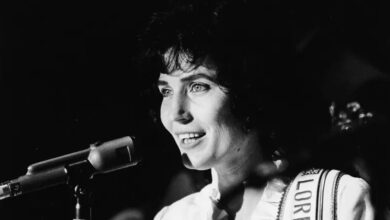Elvis Presley’s “The Girl of My Best Friend” Captures Forbidden Longing and Smooth Harmony in 1960
In 1960, as Elvis Presley emerged from his military service with renewed focus and vocal maturity, he recorded a song that quietly showcased his evolving artistry: “The Girl of My Best Friend.” Though it never received the same thunderous acclaim as his chart-topping hits, it remains one of the most emotionally nuanced performances in Presley’s catalog. Released on the Elvis Is Back! album, the song exemplified the softer, crooning side of Elvis—one steeped in longing, restraint, and the moral tension of unspoken love. While not originally issued as a single in the U.S., it would gain popularity in Europe, eventually becoming a notable hit in the UK in 1976.
Elvis Presley, born in Tupelo, Mississippi in 1935 and raised in Memphis, was already the biggest name in popular music by the time he was drafted into the U.S. Army in 1958. Before his service, he had revolutionized the music world with a sound that merged blues, gospel, country, and rock ’n’ roll. But when he returned in 1960, many wondered how the King would reclaim his throne in a changing musical landscape. The Elvis Is Back! album, recorded just weeks after his return, gave a clear answer—Presley wasn’t just back, he was evolving.
“The Girl of My Best Friend” was written by Sam Bobrick and Beverly Ross, two prolific songwriters whose work spanned genres and decades. The lyrics tell a deceptively simple story: a man who is secretly in love with his best friend’s girlfriend. It’s a theme as old as time—romantic longing caught in the web of loyalty and social boundaries—but in Presley’s hands, the story gained emotional weight. He didn’t sing the song with bravado or melodrama; he let the ache do the talking, each line tinged with wistful hesitation.
The production of the track was handled at RCA Studio B in Nashville, with producer Steve Sholes and engineer Bill Porter overseeing the session. The arrangement leaned into a doo-wop-infused ballad style, featuring smooth background vocals, gentle rhythm guitar, and subtle piano accents. Elvis’s voice—deeper and more resonant after his two years away from the spotlight—glided over the melody with a newfound control. The Jordanaires, his long-time vocal backing group, provided harmonious counterpoints that gave the track its dreamy, nostalgic quality.
Though the song didn’t make waves in the U.S. upon its original album release, it found unexpected life overseas. In 1976, RCA released “The Girl of My Best Friend” as a single in the UK, and it soared to No. 9 on the UK Singles Chart. It was a rare instance of a previously overlooked album cut gaining major radio traction over a decade later. British fans, always known for their deep appreciation of Presley’s ballads, embraced the track’s sincerity and melody.
In cultural terms, “The Girl of My Best Friend” subtly shifted the expectations of what a Presley love song could be. It wasn’t the swaggering confidence of “Jailhouse Rock” or the playful charm of “Teddy Bear”—this was mature yearning, conflicted emotion wrapped in velvet vocals. The song also hinted at the growing divide between Elvis the teen idol and Elvis the adult interpreter. It was a signpost of a career beginning to transition into deeper emotional waters.
This track also reinforced Presley’s reputation as a master of mood. Even in songs where he wasn’t credited as the writer, Elvis had a rare gift for embodying the emotional core of a lyric. “The Girl of My Best Friend” didn’t just tell a story—it invited listeners to live inside it, to feel the ache of unspoken desire, the weight of friendship versus feeling. That kind of emotional storytelling would influence a generation of singers, from Roy Orbison to Chris Isaak.
The song has been covered by a variety of artists, including Ral Donner, whose 1961 version became a hit in its own right and is often mistaken for Presley himself due to Donner’s uncanny vocal resemblance. However, Elvis’s interpretation remains definitive—not just because of his voice, but because of the quiet vulnerability he brings to the narrative.
Interestingly, Presley recorded the song during a period of personal and professional recalibration. Having just returned from the Army, he was navigating how to grow beyond the image of the swiveling-hipped rebel. “The Girl of My Best Friend” fit neatly into that evolution—showcasing an Elvis who could sing about complex, adult feelings without losing the magnetism that made him a star.
Over the decades, the song has earned a quiet reverence among Presley fans and music historians alike. It’s not always listed among his biggest hits, but it often surfaces on “underrated Elvis” lists or as a fan-favorite deep cut. Its resurgence in the UK proved that some songs just need time—and the right ears—to be fully appreciated.
In hindsight, “The Girl of My Best Friend” also helped pave the way for future pop ballads that explored morally ambiguous emotions. It showed that love songs didn’t always need to end in triumph or tragedy; sometimes, the power was in the unresolved tension, in what was left unsaid.
Though never awarded or tied to a particular milestone in Presley’s career, the song endures because of its truth. Everyone, at some point, has felt the sting of wanting what they can’t have—especially when it’s wrapped up in someone else’s happiness. That timeless emotional conflict gives the song its staying power.
Today, “The Girl of My Best Friend” remains a testament to Elvis Presley’s depth as a vocalist and interpreter of song. It’s a reminder that beneath the rhinestones and fanfare was a man with the voice to carry quiet heartbreak straight to the heart. In an era when bigger often meant better, this soft-spoken confession stood out by doing the opposite.
More than six decades after it was first recorded, the song still resonates—proof that sometimes, the most lasting moments in music are not the loudest ones, but the ones that whisper what we dare not say out loud.



